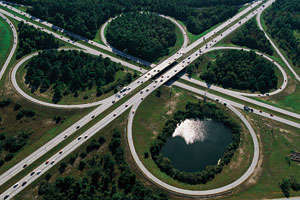Two articles in Sunday’s Commercial Appeal could have been “tombstoned,” which, in the parlance of newspaper journalism, means the headlines and stories are side-by-side. Of course, in journalism, tombstoning is not a good thing.
Tombstoning is no good for Memphis either, and it’s tempting for a tombstone to be the apt metaphor for two articles with these headlines:
“Memphis sinking in debt, city council hears”
“Critics question Fayette County I-40 interchange project”
Rarely have cause and effect been clearer.
Welcomed Candor
At the weekend budget retreat of Memphis city government, the forces shaping the budgets of Memphis were fully and honestly chronicled for the first time in our memories. There were foreclosure numbers, bonded indebtedness numbers, property tax trends, and density and population trends, homeowners upside down in their home values (30%), and the large percentage of Memphis property that is tax-exempt (30%).
As one Council member said: “It was the most candid presentation of the ‘real facts’ by an administration during my years on Council. It was a refreshing switch because we are usually spoon fed select information. Every year we fumble from crisis to crisis, so maybe we can take a step back and figure out what’s causing them. Maybe now we’re on the same page, if the political gamesmanship can be put off.”
The theme of the retreat punctuated one delivered regularly by Memphis Mayor A C Wharton in the past two years: Memphis has no margin for error. That’s why he said that he’s starting to develop a five-year strategic fiscal plan to bring more reliable forecasting and planning to city budgeting.
He highlighted his concern in his January 23 State of the City address, calling the five-year plan “the blueprint for future decision-making about operating and debt service expenditures, revenues, capital costs, maintenance costs, staffing, asset management, and OPEB funding…(and) requires us to put everything on the table, beginning with an unbiased, objective look at the operations and financing of government services.
“It includes right-sizing government, managed competition, better deployment of our workforce, the location and number of public facilities, better uses of city-owned buildings in prime locations so they generate property taxes, joint service agreements with other public entities, and a comprehensive look at the kind of tax structure that is more equitable to Memphis taxpayers.”
Budget Fixes Not Quick
In his speech, Mayor Wharton said there are no “quick fixes” to the city’s budget dilemma, and there can be no argument about that following Saturday’s budget retreat. It painted the portrait of a city government that has to successfully do a lot of things right to bring discipline to its financial operations.
He also said that city government must examine the “interlocking factors that drive the city budget.”
We need to look no further than the headline about the bone-headed plans for a massive $30 million I-40 cloverleaf interchange only 12 miles from Wolfchase Galleria, according to the ever accurate CA reporter Tom Charlier. The interchange is just over the Fayette County line so the few hundred cars using Tennessee Highway 196 (Hickory Wythe Road) can enter and exit the interstate instead of driving a few miles to an existing interchange — five miles to the east (SR-59) or two miles to the west (New Airline Road).
To the credit of the Memphis Metropolitan Planning Organization, it could hear the stirrings of a giant sucking sound and initially deferred approval after Memphis, Germantown, and Bartlett officials expressed concerns.
In the last presidential election, we heard a lot about the “bridge to nowhere” in Alaska, but back here at home, a “cloverleaf to nowhere” remains on the drawing board. Well, we don’t mean to overstate it; it’s not exactly nowhere – there are probably about 3,500 people in this part of Fayette County.
MPO Blinked
To prove how complete the brainwashing is by the asphalt lobby and roadbuilding industry, the MPO stampeded after TDOT threatened that the money for the interchange could be moved to other parts of Tennessee if MPO didn’t approve the interchange.
We should be so lucky. Unfortunately, the MPO blinked, and unbelievably, the Bartlett engineer even said: “We don’t want to lose it because it’s jobs for the area.”
It’s the kind of nonsensical statement that results from the prevailing mythology here that all roads are good roads. It’s naïve to say the project is good because it produces roadbuilding jobs in Fayette County. More to the point, does anyone even bother to calculate the negative impact on the economic engine for the entire region – Shelby County?
We are way past the time when these kinds of one-sided analyses of projects should be rubber stamped in the name of economic growth and economic development, terms routinely attached to projects that in the long term undermine the primary city where about 75% of the jobs and wages originate.
But the nonsense deepened with Fayette County Mayor Rhea Taylor adding that the project will control sprawl, not aggravate sprawl, because the interchange will concentrate development “where it’s meant to be.” We’d love for him to point to a cloverleaf interchange in the Mid-South that justifies this twisted understanding of smart growth.
But, to borrow one of the town mayors’ favorite metaphors, the train has probably already left the station, because of a TDOT tactics that dates back decades. TDOT begins a project by investing several hundred thousands of dollars in engineering and design, and then they use that expense to justify buying millions of dollars of right of way while they evaluate the timing for the project. So, about the time the public becomes widely aware of the project, TDOT’s answer is that it has already spent significant money on the project so it needs to plow ahead.
It’s a formula for success that TDOT’s engineers have mastered, and only attorney Charles Newman and the little ladies in tennis shoes halt to an interstate through Overton Park stands as testament that the bulldozers can be turned back. Then again, even as the federal lawsuit was being heard, TDOT was building the highway (now Sam Cooper Parkway) directly at the park, and then, unsurprisingly, justified the route in federal court by testifying that they had already spent millions aiming I-40 straight at its heart. For once, a judge rejected their argument out of hand.
At a time when Tennessee Governor Bill Haslam says that Tennessee’s success depends on Memphis’ success, TDOT and MPO have yet again moved ahead with a massive project that wastes money needed for projects on much, much more heavily-traveled highways in the more populated areas of Memphis.
As we have learned from the single-minded push for I-269, there is little regard given by our road planners, road builders, and developers about the long-term impact of their projects on the fiscal and economic health of the city that powers the entire region. Instead, millions of dollars will be spent on the new Fayette County interchange to serve SR 196, “currently a rural two lane, non-access controlled road.” “Land use in the project area is primarily rural with cotton fields and a sod farm,” TDOT wrote.
Justifications
“Commuters from this area primarily use I-40 to travel to jobs in urban and suburban Memphis areas,” the TDOT report said, failing to point out that once again transportation planning rewards the same people who abandon urban areas and whose decisions are now to be subsidized by the rest of us.
Most damning is the fact that the TDOT “assessments” repeat economic projections as if they are fact and rosy predictions as if they are reality. Nowhere can be found any research that calls into question the methodology that unfailingly supports the construction of every highway project and misstates and exaggerates the effects of congestion or take into account trends lines moving in favor of urban living as a result of gas prices, housing markets, and livability issues.
Instead, we get conclusions like this from TDOT, which shamelessly wrote with no sense of irony: “The Memphis Area Transit Authority system does not reach this far from the central metropolitan areas. The closest bus route is over ten miles away.”
It is of course a self-fulfilling prophecy since TDOT has acted for years like public transit has been the third rail of state transportation planning for decades. Then again, public transit doesn’t enrich politically connected landowners, developers, and roadbuilders.
Paying Twice
Meanwhile, back at the city budget retreat, City Council reviewed charts and graphs that showed that Memphis’ population density per square mile has been halved in the past 40 years and that the city’s population has been propped up by annexations that doubled the land area of Memphis as it chased the citizens who relocated outside Memphis into the unsustainable sprawl of Shelby County.
And to top it off, Memphis taxpayers paid the price twice – once when they paid for the highways that fueled the sprawl and twice when they paid for the cost of city services driven up by core city neighborhoods where the population dropped by 30-50%.





Good article as always, and I can understand why many leaders in Shelby County (not just Memphis, but Bartlett and Germantown) are frustrated by TDOT’s plan to spend $30 million on building a new interchange in Fayette County. If anything, that money could have (and should have) been best spent on completing some of the high priority road projects in Memphis and Shelby County first that TDOT committed to doing in the past, but either never started or never finished (i.e., the I-40/I-240 eastern interchange). The sad thing, however, is that not even our elected leaders at the state level are fighting hard enough for Shelby County to even prioritize having some of these projects finished. Instead, those priorities have mostly taken a back seat to the partisan political games being played in Nashville at the moment.
Or elected state leaders are too busy trying to pass don’t say gay bills to pay attention to anything serious.
Watch out Wolfchase and Cordova. That big sucking sound you will hear in the future is the sound of all those big box stores moving yet further east in search of their next white way.